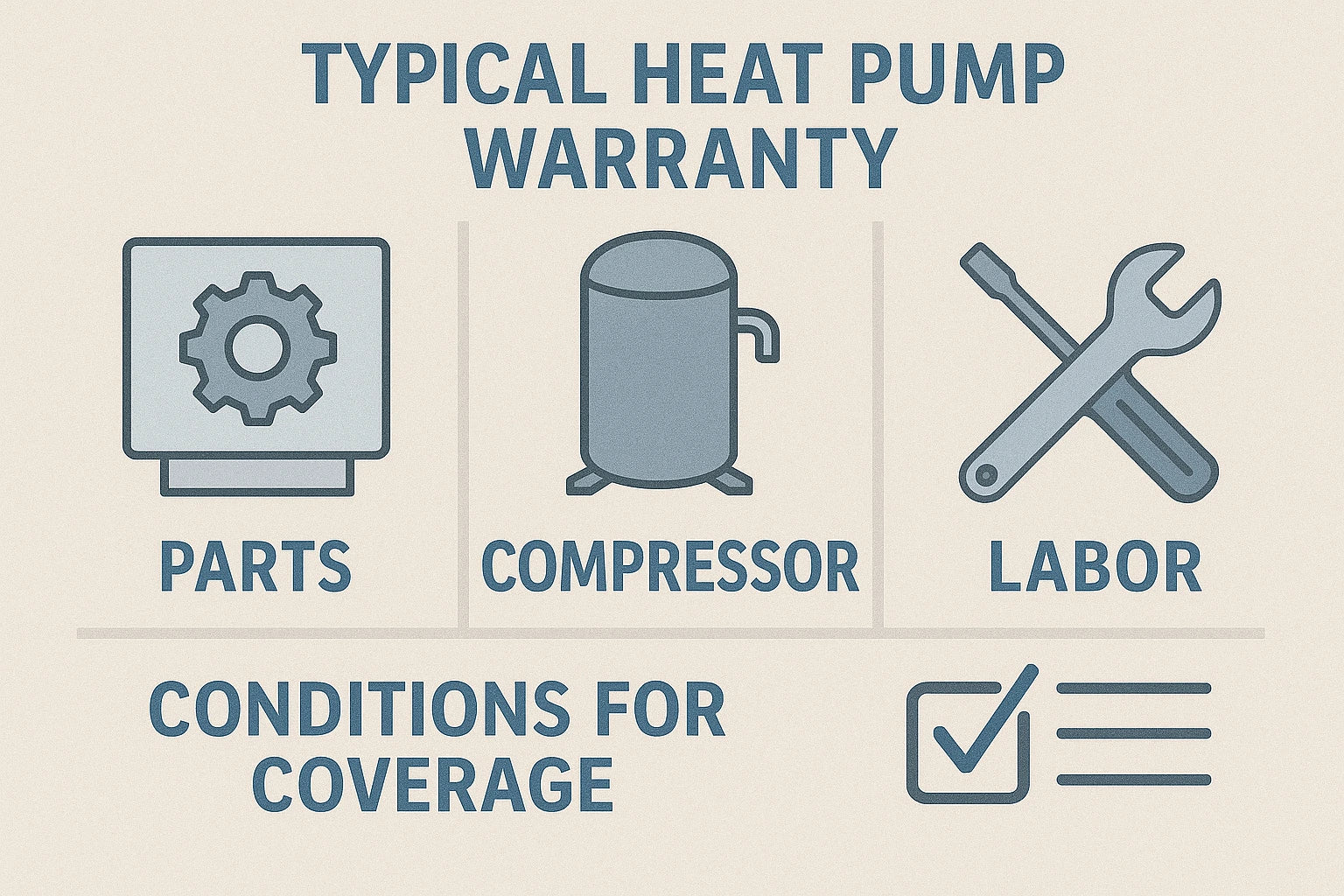If you’ve been pricing out heat pumps, you’ve probably noticed that installation can account for 40–60% of the total cost. That’s why many homeowners consider taking the DIY route — especially with the rise of “DIY-friendly” kits like MrCool.
But there’s one big question that could make or break your decision: Will a self-install void your manufacturer warranty?
In this guide, we’ll break down how warranties work, which brands allow homeowner installation, and how to protect your coverage if you decide to go DIY.
For a complete look at every step of installation, see the Complete Guide to DIY Heat Pump Installation.
How Manufacturer Warranties Work for Heat Pumps
A manufacturer warranty is your safety net against defects in materials or workmanship. It’s not meant to cover mistakes during installation or regular maintenance issues — but it can save you thousands if a major component fails early.
What Warranties Typically Cover
-
Compressor – Usually covered for the longest term (5–12 years)
-
Parts – Covers indoor and outdoor unit components
-
Labor – Often excluded unless you purchase an extended warranty through an installer
Coverage Duration
Many brands offer a 5-year parts warranty by default and extend it to 10–12 years if you register the product within a set period (often 60–90 days after installation).
Registration Requirements
Failure to register your product can shorten coverage. 📘 The U.S. Department of Energy notes that some manufacturers also require proof of proper installation as part of their registration process.
Why DIY Installation Can Affect Warranty Coverage
Here’s the hard truth: most major HVAC brands require installation by a licensed contractor for warranty coverage to remain valid.
1. Lack of Licensed Installer Documentation
Manufacturers want proof that your system was installed correctly and in compliance with local codes. Without a licensed contractor’s invoice, they may deny claims.
2. Risk of Missed Steps
If you skip required procedures — like pressure testing and vacuuming — the system could fail early. Even if the failure seems unrelated, the manufacturer could argue that improper installation was the cause.
3. Code Compliance Issues
Some jurisdictions require inspections for electrical or refrigerant work. Skipping these steps could leave you without legal or warranty protection. Energy Star’s HVAC Installation Guidance highlights that poor installation can reduce efficiency by up to 30% — a common reason claims get denied.
Brand-by-Brand Policies on DIY Installations
Warranty rules vary widely by manufacturer.
Brands Allowing Homeowner Installation
-
MrCool – Their DIY mini-split kits come with pre-charged lines and are designed for homeowner installation. MrCool’s warranty page confirms that coverage applies if you follow their instructions and register the product.
Brands Requiring Licensed Pros
-
Mitsubishi, Daikin, Fujitsu, LG, Carrier – All require professional installation for warranty coverage. Even if you buy the unit online, you’ll need an installer’s documentation to activate the warranty.
The Hybrid Approach
Some homeowners hire a licensed HVAC tech just for the final connection and system startup. This can keep most of the labor savings while preserving warranty coverage — but check with the brand first.
Steps to Protect Your Warranty as a DIYer
If you go the DIY route, you can still improve your odds of keeping coverage intact:
-
Follow the Installation Manual Exactly
Deviating from the manufacturer’s instructions can void your warranty. -
Keep All Receipts and Records
Save proof of purchase for the unit, tools, and materials. -
Pull Required Permits and Pass Inspections
This shows the work meets local code requirements. 📘 The Federal Trade Commission notes that warranty law allows manufacturers to require proof of proper installation. -
Use Approved Tools and Materials
Some brands specify tool types (e.g., torque wrench, micron gauge) in their manuals. -
Register the Product Promptly
Complete online or mail-in registration within the time frame given.
When It’s Worth Hiring a Pro for Warranty Reasons
Even the most capable DIYer should consider professional help in certain situations:
-
High-efficiency, multi-zone systems – More complexity means more risk.
-
Labor warranties tied to certified installers – Some brands offer extended labor coverage only if a certified tech does the work.
-
Local code requirements – If your area requires licensed work for certain parts of the job, skipping this could void both your permit and your warranty.
Cost of Losing Your Warranty
It might be tempting to skip the pro install and save money upfront, but consider the potential cost of losing your warranty:
-
Compressor replacement: $1,200–$2,500
-
Outdoor coil replacement: $900–$1,500
-
Control board replacement: $400–$800
One major failure can wipe out your entire installation savings.
Final Thoughts from Alex
DIY heat pump installation can be a smart way to cut costs — but warranties aren’t something to take lightly. While brands like MrCool make DIY-friendly kits that keep coverage intact, most major manufacturers require professional installation to honor their warranty.
If you choose to go DIY, document everything, follow the manual, and register your unit on time. And if your system is high-end or complex, hiring a pro might be the best insurance policy you can buy.
Next up: How to Run Line Sets and Drain Tubing Safely and Neatly — learn how to keep your installation looking professional while protecting your system from leaks and damage.
Alex Lane
Your Home Comfort Advocate







